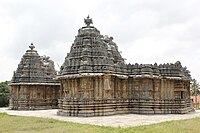Veera Ballala II
| Veera Ballala II | |
|---|---|
Hoysala |
| Hoysala Kings | ||||||||||||||||||||||||
|---|---|---|---|---|---|---|---|---|---|---|---|---|---|---|---|---|---|---|---|---|---|---|---|---|
|
||||||||||||||||||||||||





Veera Ballala II (
His court was adorned with some of the most notable of medieval
Wars against the neighbouring kingdoms
Ballala II's ascendancy to the Hoysala throne in c. 1173 was preceded by his successful rebellion against his weak father
The real contention now, for the territories in the
Relationship with Cholas
Around c. 1216, Maravarman Sundara Pandya ascended the throne at Madurai. To seek revenge for the humiliation of his elder brother Jatavarman Kulashekara by the Chola monarch Kulothunga III, he invaded the Chola territory and drove Kulothunga into exile. Kulothunga III sought the help of the Hoysalas.
Patron of art and architecture
Veera Ballala II was a great patron of Kannada literature. Janna, one of the most influential Kannada poets of the 13th century, graced his court and was honored with the title Kavichakravarthi ("Emperor among poets"). His most noteworthy writing and magnum opus, the Yashodhara Charitre (c. 1209) deals with
Ballala II's rule saw the proliferation of the temple construction adhering to the
Ballala II donated Meruhalli village and other lands in 1174 CE for providing food to Jain monks.[25] He further gifted two villages to Vajranandi-Siddhantadeva for the same purpose.[25] Nanjedevaragudda stone inscription of 1192 CE describes the donations by Hoysala rulers and subjects for Jain monks at Abhinava Shantideva temple at Somepur, Hassan district.[25]
References
Citations
- ^ Kamath (1980), pp.126-127
- ^ Chopra, Ravindran and Subrahmanian (2003), part I, pp.154-155
- ^ Sastri (1955), p.193
- ISBN 978-9-38060-734-4.
- ISBN 978-81-269-0027-5
- ^ a b c Kamath (1980), p.126
- ^ a b c d e Kamath (1980), p.127
- ^ a b E.P. Rice (1921), p.43
- ^ a b Chopra, Ravindran and Subrahmanian (2003), part I, p.154
- ^ a b c Sastri (1955), p.180
- ^ a b Kamath (1980), p.129
- ^ a b Sastri (1955), pp.193-194
- ^ a b Sen 1999, p.499
- ^ a b Thapar (2003), p.368
- ^ a b Chopra, Ravindran and Subrahmanian (2003) p155, part1
- ^ Keay (2000), p.252
- ^ Sastri (1955), pp. 358–359
- ^ Kamath (1980), p. 133
- ^ Sastri (1955), p.358
- ^ Narasimhacharya (1988), p20
- ^ Sastri (1955), p.364
- ^ Kamath (1980), p. 134
- ^ Foekema (1996), p.53
- ^ Foekema (1996), p.82
- ^ a b c Ram Bhushan Prasad Singh 2008, p. 84.
Sources
- Chopra, P.N.; Ravindran, T.K.; Subrahmanian, N (2003) [2003]. History of South India (Ancient, Medieval and Modern) Part 1. New Delhi: Chand Publications. ISBN 81-219-0153-7.
- Foekema, Gerard (1996) [1996]. A Complete Guide To Hoysala Temples. New Delhi: Abhinav. ISBN 81-7017-345-0.
- Kamath, Suryanath U. (2001) [1980]. A concise history of Karnataka: from pre-historic times to the present. Bangalore: Jupiter books. OCLC 7796041.
- Keay, John (2000) [2000]. India: A History. New York: Grove Publications. ISBN 0-8021-3797-0.
- Majumdar, Ramesh Chandra (1977) [1952]. Ancient India. New Delhi: Motilal Banarsidass. ISBN 81-208-0436-8.
- Narasimhacharya, R (1988) [1988]. History of Kannada Literature. New Delhi, Madras: Asian Educational Services. ISBN 81-206-0303-6.
- Rice, E.P. (1982) [1921]. A History of Kanarese Literature. New Delhi: Asian Educational Services. ISBN 81-206-0063-0.
- Sen, Sailendra Nath (1999) [1999]. Ancient Indian History and Civilization. New Age Publishers. ISBN 81-224-1198-3.
- Sastri, K.A. Nilakanta (2002) [1955]. A history of South India from prehistoric times to the fall of Vijayanagar. New Delhi: Indian Branch, Oxford University Press. ISBN 0-19-560686-8.
- Singh, Ram Bhushan Prasad (2008) [1975], Jainism in Early Medieval Karnataka, ISBN 978-81-208-3323-4
- Thapar, Romila (2003) [2003]. The Penguin History of Early India. New Delhi: Penguin Books. ISBN 0-14-302989-4.
